Data-Driven Minute-Ahead Forecast of PV Generation with Adjacent PV Sector Information
Abstract
1. Introduction
2. Related Work
3. Forecast Model
3.1. Learning Model
- ;
- ;
- ;
3.2. Input Data
4. Experimental Result
4.1. Experiment Setup
4.2. Performance Comparison
5. Conclusions
Author Contributions
Funding
Data Availability Statement
Conflicts of Interest
References
- Antonanzas, J.; Osorio, N.; Escobar, R.; Urraca, R.; Martinez-de-Pison, F.J.; Antonanzas-Torres, F. Review of Photovoltaic Power Forecasting. Sol. Energy 2016, 136, 78–111. [Google Scholar] [CrossRef]
- Blaga, R.; Sabadus, A.; Stefu, N.; Dughir, C.; Paulescu, M.; Badescu, V. A Current Perspective on the Accuracy of Incoming Solar Energy Forecasting. Prog. Energy Combust. Sci. 2019, 70, 119–144. [Google Scholar] [CrossRef]
- Shi, Q.; Feng, W.; Zhang, Q.; Wang, X.; Li, F. Overvoltage Mitigation through Volt-Var Control of Distributed PV Systems. In Proceedings of the 2020 IEEE/PES Transmission and Distribution Conference and Exposition (T&D), Chicago, IL, USA, 12–15 October 2020; IEEE: Piscataway, NJ, USA; pp. 1–5. [Google Scholar]
- News, Josun Biz (In Korean). Available online: https://biz.chosun.com/policy/policy_sub/2023/04/25/WG7AH55FDFGUFI4K65GJGQSB3E/?utm_source=naver&utm_medium=original&utm_campaign=biz (accessed on 27 April 2023).
- Lin, K.-P.; Pai, P.-F. Solar Power Output Forecasting Using Evolutionary Seasonal Decomposition Least-Square Support Vector Regression. J. Clean. Prod. 2016, 134, 456–462. [Google Scholar] [CrossRef]
- Yang, D. Choice of Clear-Sky Model in Solar Forecasting. J. Renew. Sustain. Energy 2020, 12, 026101. [Google Scholar] [CrossRef]
- Pan, M.; Li, C.; Gao, R.; Huang, Y.; You, H.; Gu, T.; Qin, F. Photovoltaic Power Forecasting Based on a Support Vector Machine with Improved Ant Colony Optimization. J. Clean. Prod. 2020, 277, 123948. [Google Scholar] [CrossRef]
- Hochreiter, S.; Schmidhuber, J. Long Short-Term Memory. Neural Comput. 1997, 9, 1735–1780. [Google Scholar] [CrossRef] [PubMed]
- Hossain, M.S.; Mahmood, H. Short-Term Photovoltaic Power Forecasting Using an LSTM Neural Network and Synthetic Weather Forecast. IEEE Access 2020, 8, 172524–172533. [Google Scholar] [CrossRef]
- Kothona, D.; Panapakidis, I.P.; Christoforidis, G.C. A Novel Hybrid Ensemble LSTM-FFNN Forecasting Model for Very Short-Term and Short-Term PV Generation Forecasting. IET Renew. Power Gener. 2022, 16, 3–18. [Google Scholar] [CrossRef]
- López Santos, M.; García-Santiago, X.; Echevarría Camarero, F.; Blázquez Gil, G.; Carrasco Ortega, P. Application of Temporal Fusion Transformer for Day-Ahead PV Power Forecasting. Energies 2022, 15, 5232. [Google Scholar] [CrossRef]
- Ahmed, R.; Sreeram, V.; Mishra, Y.; Arif, M.D. A Review and Evaluation of the State-of-the-Art in PV Solar Power Forecasting: Techniques and Optimization. Renew. Sustain. Energy Rev. 2020, 124, 109792. [Google Scholar] [CrossRef]
- Gupta, P.; Singh, R. PV Power Forecasting Based on Data-Driven Models: A Review. Int. J. Sustain. Eng. 2021, 14, 1733–1755. [Google Scholar] [CrossRef]
- Alkhayat, G.; Mehmood, R. A Review and Taxonomy of Wind and Solar Energy Forecasting Methods Based on Deep Learning. Energy AI 2021, 4, 100060. [Google Scholar] [CrossRef]
- Tina, G.M.; Ventura, C.; Ferlito, S.; De Vito, S. A State-of-Art-Review on Machine-Learning Based Methods for PV. Appl. Sci. 2021, 11, 7550. [Google Scholar] [CrossRef]
- Ogliari, E.; Dolara, A.; Manzolini, G.; Leva, S. Physical and Hybrid Methods Comparison for the Day Ahead PV Output Power Forecast. Renew. Energy 2017, 113, 11–21. [Google Scholar] [CrossRef]
- Li, Y.; He, Y.; Su, Y.; Shu, L. Forecasting the Daily Power Output of a Grid-Connected Photovoltaic System Based on Multivariate Adaptive Regression Splines. Appl. Energy 2016, 180, 392–401. [Google Scholar] [CrossRef]
- Box, G.E.P.; Jenkins, G.M.; Reinsel, G.C.; Ljung, G.M. Time Series Analysis: Forecasting and Control; John Wiley & Sons: Hoboken, NJ, USA, 1970; ISBN 978-1-118-67492-5. [Google Scholar]
- Liu, Z.-F.; Li, L.-L.; Tseng, M.-L.; Lim, M.K. Prediction Short-Term Photovoltaic Power Using Improved Chicken Swarm Optimizer-Extreme Learning Machine Model. J. Clean. Prod. 2020, 248, 119272. [Google Scholar] [CrossRef]
- Zhou, Y.; Zhou, N.; Gong, L.; Jiang, M. Prediction of Photovoltaic Power Output Based on Similar Day Analysis, Genetic Algorithm and Extreme Learning Machine. Energy 2020, 204, 117894. [Google Scholar] [CrossRef]
- Dewangan, C.L.; Singh, S.N.; Chakrabarti, S. Combining Forecasts of Day-Ahead Solar Power. Energy 2020, 202, 117743. [Google Scholar] [CrossRef]
- Yin, W.; Han, Y.; Zhou, H.; Ma, M.; Li, L.; Zhu, H. A Novel Non-Iterative Correction Method for Short-Term Photovoltaic Power Forecasting. Renew. Energy 2020, 159, 23–32. [Google Scholar] [CrossRef]
- Sharadga, H.; Hajimirza, S.; Balog, R.S. Time Series Forecasting of Solar Power Generation for Large-Scale Photovoltaic Plants. Renew. Energy 2020, 150, 797–807. [Google Scholar] [CrossRef]
- Jallal, M.A.; Chabaa, S.; Zeroual, A. A Novel Deep Neural Network Based on Randomly Occurring Distributed Delayed PSO Algorithm for Monitoring the Energy Produced by Four Dual-Axis Solar Trackers. Renew. Energy 2020, 149, 1182–1196. [Google Scholar] [CrossRef]
- Korea Energy Market Operation Protocol, Korea power exchanage: Naju, Jeollanam-do, Korea. Available online: https://www.kpx.or.kr/board.es?mid=a11002010000&bid=0030&act=view&list_no=69371 (accessed on 10 May 2023). (In Korean).
- Rana, M.; Koprinska, I.; Agelidis, V.G. Univariate and Multivariate Methods for Very Short-Term Solar Photovoltaic Power Forecasting. Energy Convers. Manag. 2016, 121, 380–390. [Google Scholar] [CrossRef]
- Sheng, H.; Xiao, J.; Cheng, Y.; Ni, Q.; Wang, S. Short-Term Solar Power Forecasting Based on Weighted Gaussian Process Regression. IEEE Trans. Ind. Electron. 2018, 65, 300–308. [Google Scholar] [CrossRef]
- Huang, J.; Khan, M.M.; Qin, Y.; West, S. Hybrid Intra-Hour Solar PV Power Forecasting Using Statistical and Skycam-Based Methods. In Proceedings of the 2019 IEEE 46th Photovoltaic Specialists Conference (PVSC), Chicago, IL, USA, 16–21 June 2019; pp. 2434–2439. [Google Scholar]
- De Giorgi, M.G.; Congedo, P.M.; Malvoni, M. Photovoltaic Power Forecasting Using Statistical Methods: Impact of Weather Data. IET Sci. Meas. Amp Technol. 2014, 8, 90–97. [Google Scholar] [CrossRef]
- Das, U.K.; Tey, K.S.; Seyedmahmoudian, M.; Mekhilef, S.; Idris, M.Y.I.; Van Deventer, W.; Horan, B.; Stojcevski, A. Forecasting of Photovoltaic Power Generation and Model Optimization: A Review. Renew. Sustain. Energy Rev. 2018, 81, 912–928. [Google Scholar] [CrossRef]
- Peng, Z.; Yu, D.; Huang, D.; Heiser, J.; Yoo, S.; Kalb, P. 3D Cloud Detection and Tracking System for Solar Forecast Using Multiple Sky Imagers. Sol. Energy 2015, 118, 496–519. [Google Scholar] [CrossRef]
- Al-Dahidi, S.; Ayadi, O.; Alrbai, M.; Adeeb, J. Ensemble Approach of Optimized Artificial Neural Networks for Solar Photovoltaic Power Prediction. IEEE Access 2019, 7, 81741–81758. [Google Scholar] [CrossRef]
- Wang, F.; Zhen, Z.; Liu, C.; Mi, Z.; Hodge, B.-M.; Shafie-khah, M.; Catalão, J.P.S. Image Phase Shift Invariance Based Cloud Motion Displacement Vector Calculation Method for Ultra-Short-Term Solar PV Power Forecasting. Energy Convers. Manag. 2018, 157, 123–135. [Google Scholar] [CrossRef]
- Yang, C.; Thatte, A.A.; Xie, L. Multitime-Scale Data-Driven Spatio-Temporal Forecast of Photovoltaic Generation. IEEE Trans. Sustain. Energy 2015, 6, 104–112. [Google Scholar] [CrossRef]
- Agoua, X.G.; Girard, R.; Kariniotakis, G. Short-Term Spatio-Temporal Forecasting of Photovoltaic Power Production. IEEE Trans. Sustain. Energy 2018, 9, 538–546. [Google Scholar] [CrossRef]
- Kashyap, Y.; Bansal, A.; Sao, A.K. Spatial Approach of Artificial Neural Network for Solar Radiation Forecasting: Modeling Issues. J. Sol. Energy 2015, 2015, 1–13. [Google Scholar] [CrossRef]
- Jeong, J.; Kim, H. Multi-Site Photovoltaic Forecasting Exploiting Space-Time Convolutional Neural Network. Energies 2019, 12, 4490. [Google Scholar] [CrossRef]
- Holmgren, W.F.; Hansen, C.W.; Mikofski, M.A. Pvlib Python: A Python Package for Modeling Solar Energy Systems. J. Open Source Softw. 2018, 3, 884. [Google Scholar] [CrossRef]
- Kingma, D.P.; Ba, J. Adam: A Method for Stochastic Optimization. arXiv 2014, arXiv:1412.6980. [Google Scholar]
- Nelson, C.R.; Plosser, C.R. Trends and Random Walks in Macroeconmic Time Series: Some Evidence and Implications. J. Monet. Econ. 1982, 10, 139–162. [Google Scholar] [CrossRef]
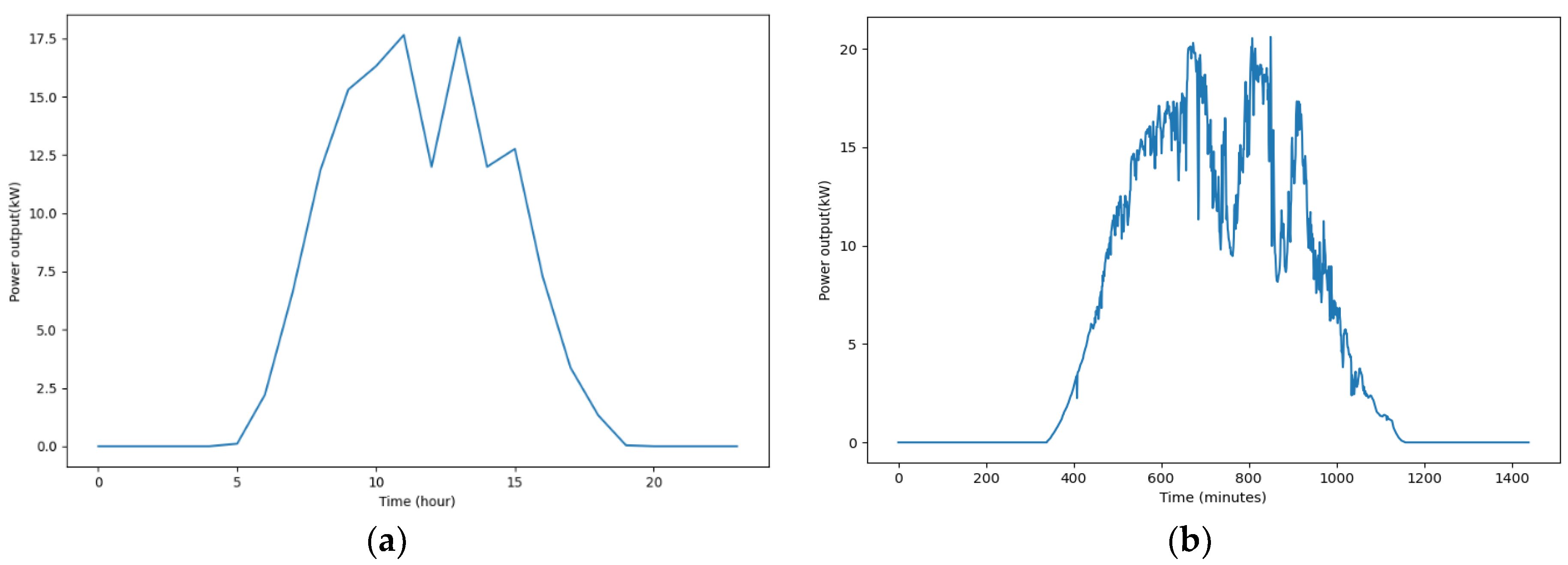
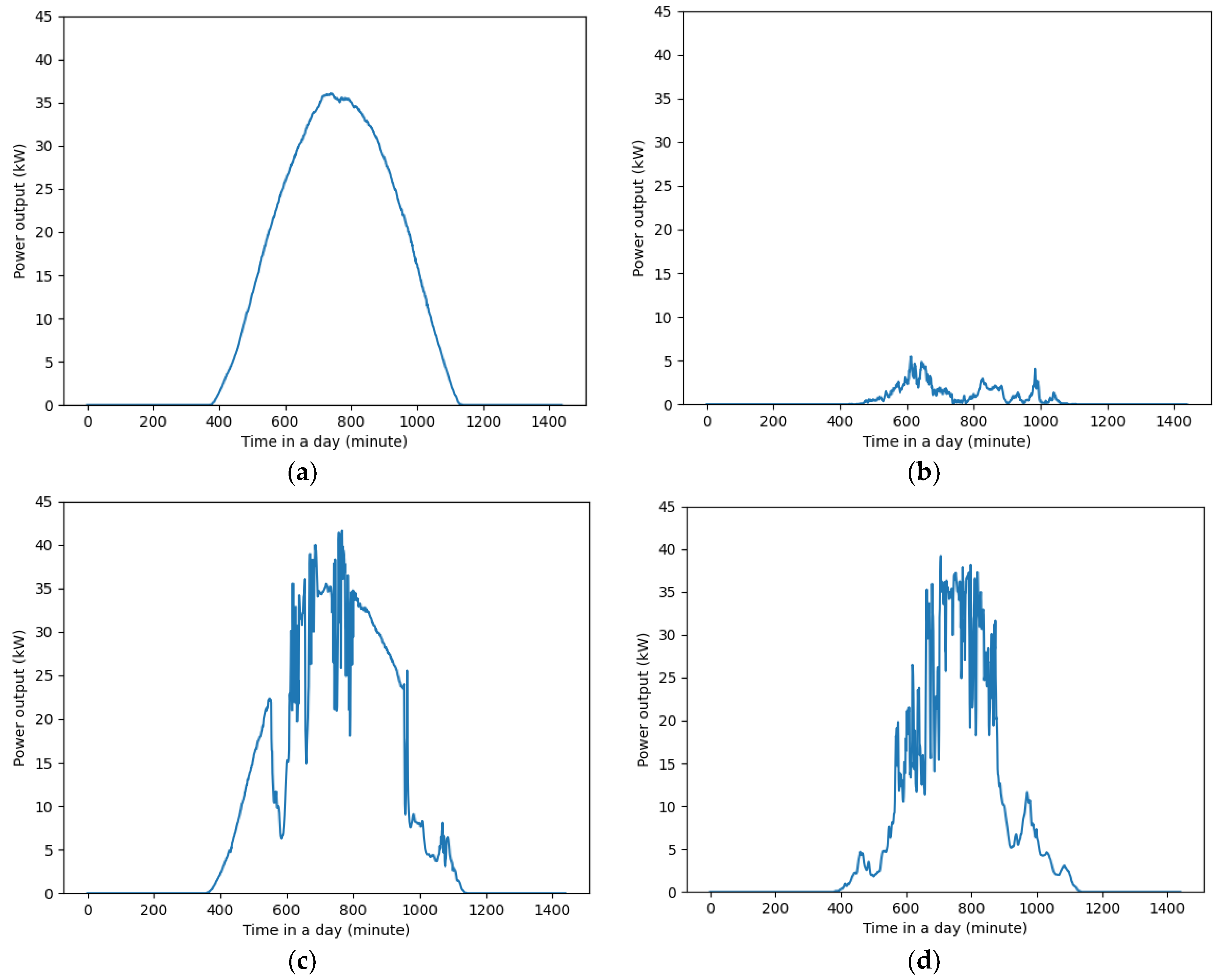
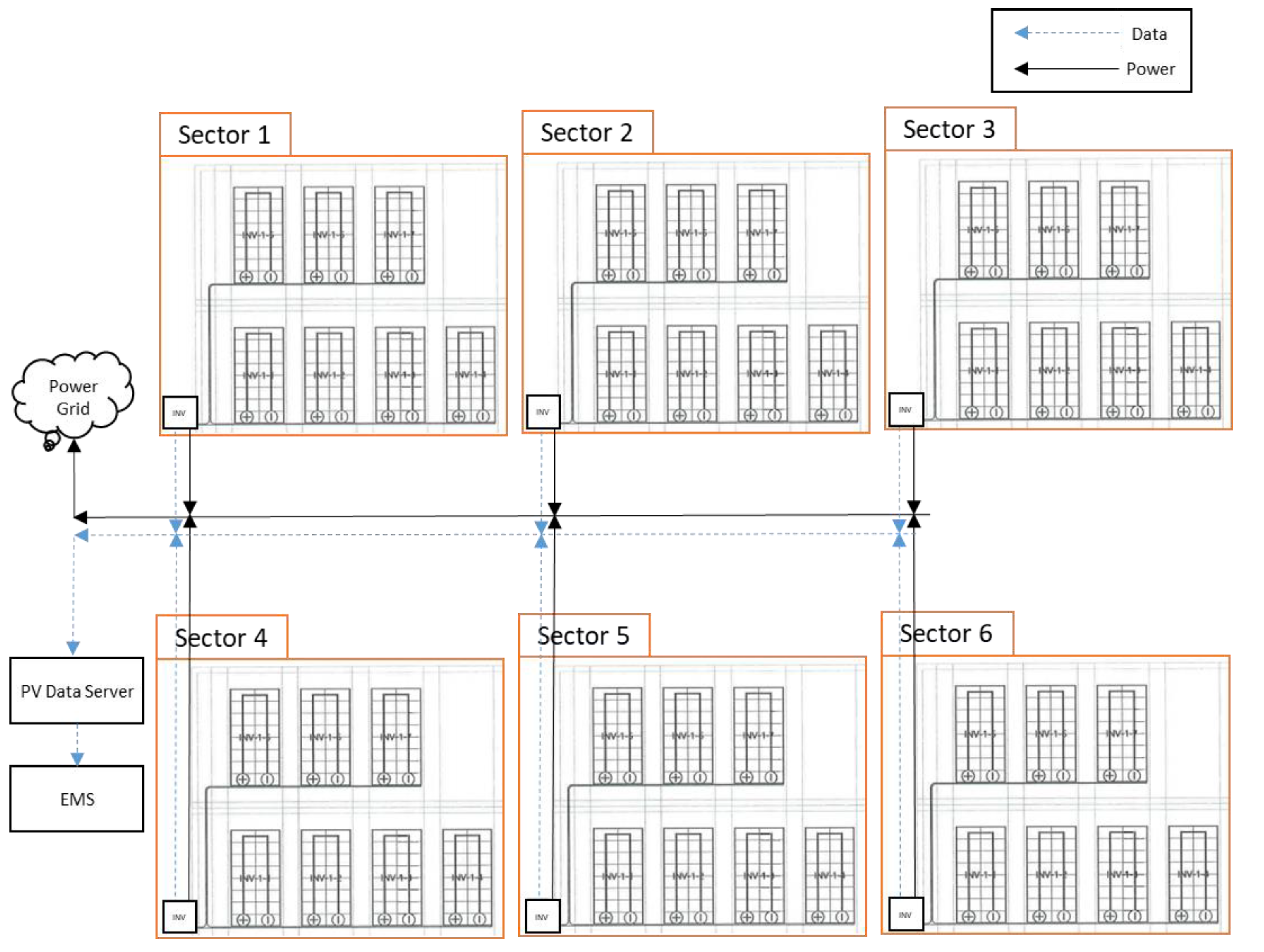
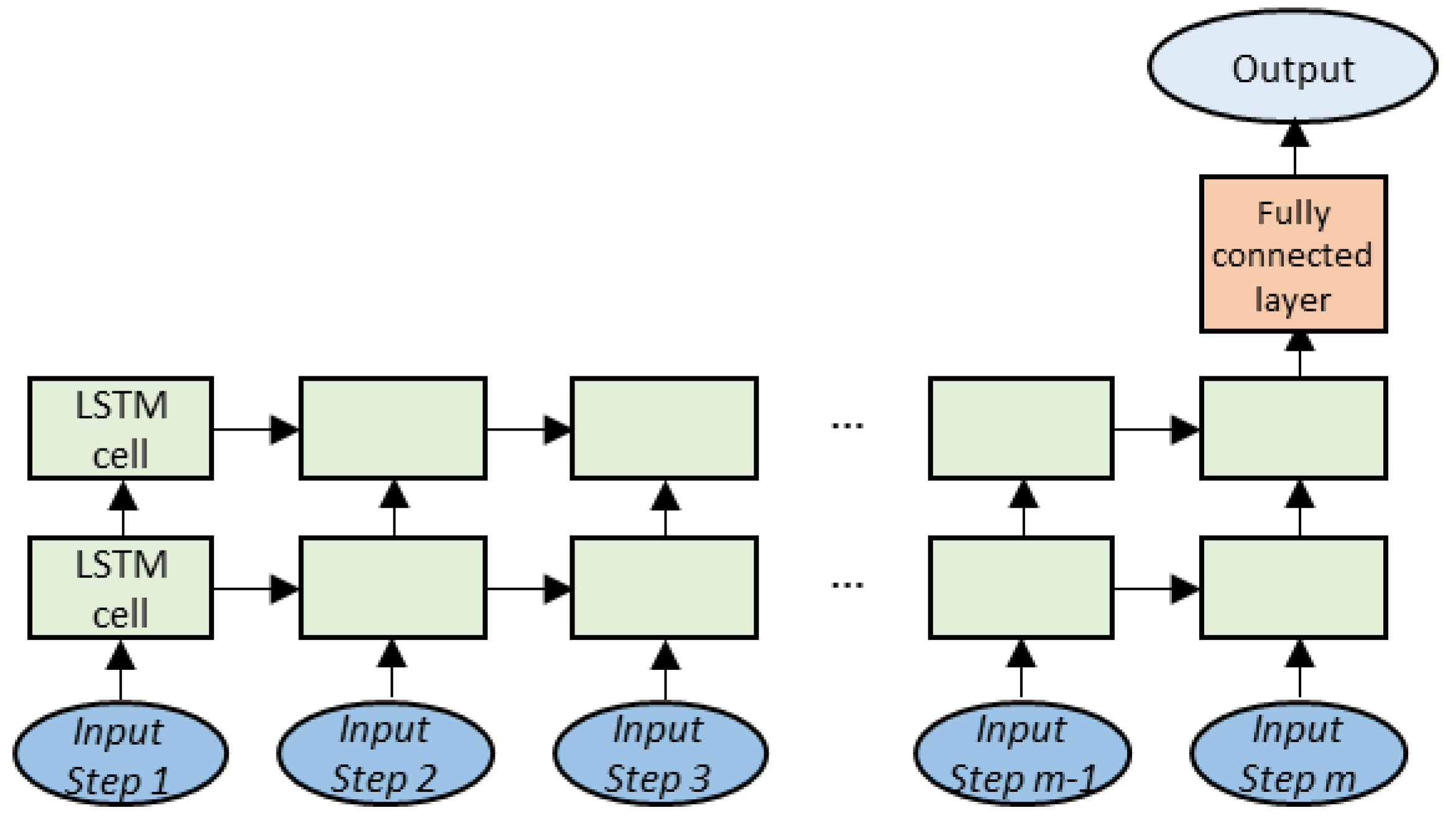
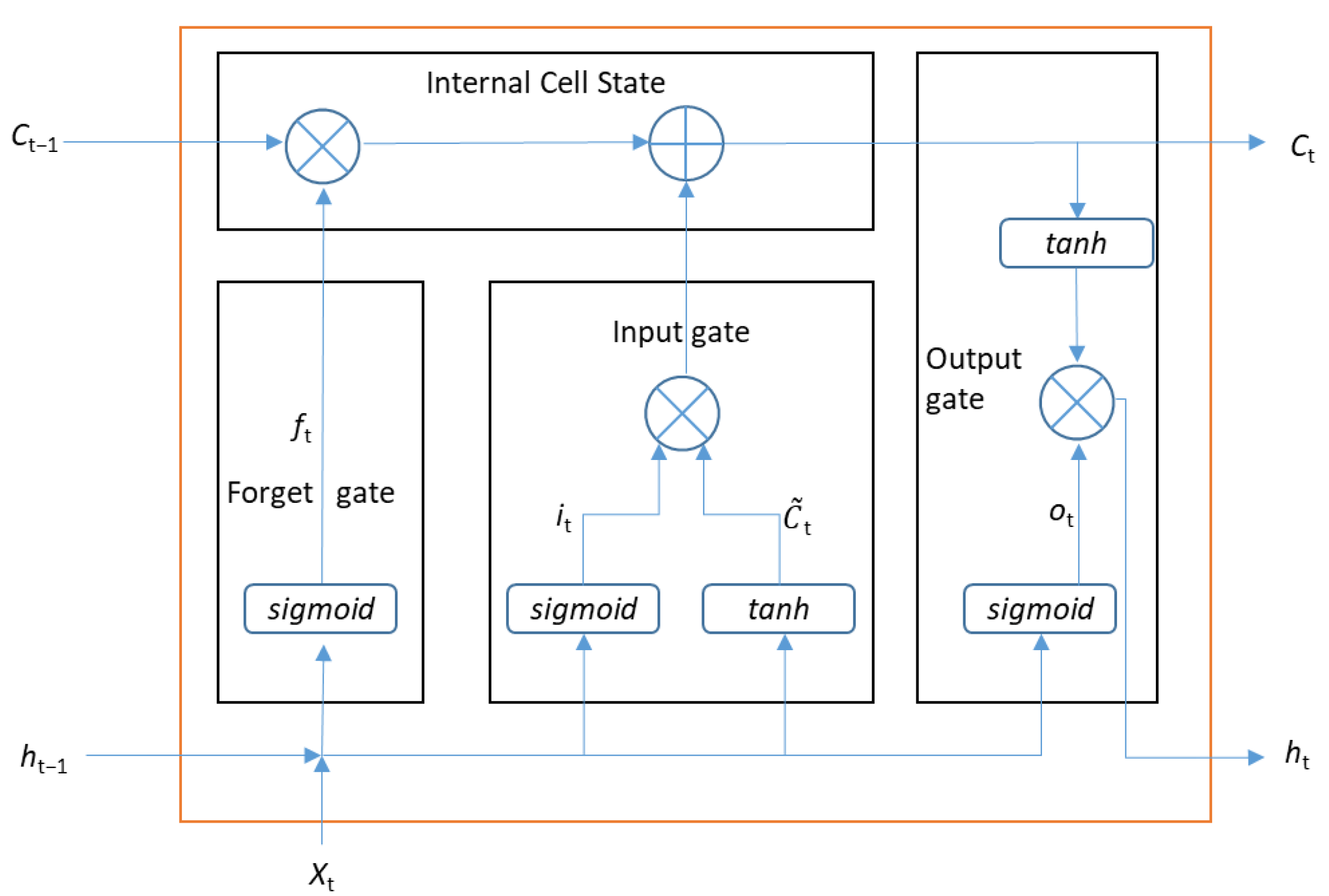
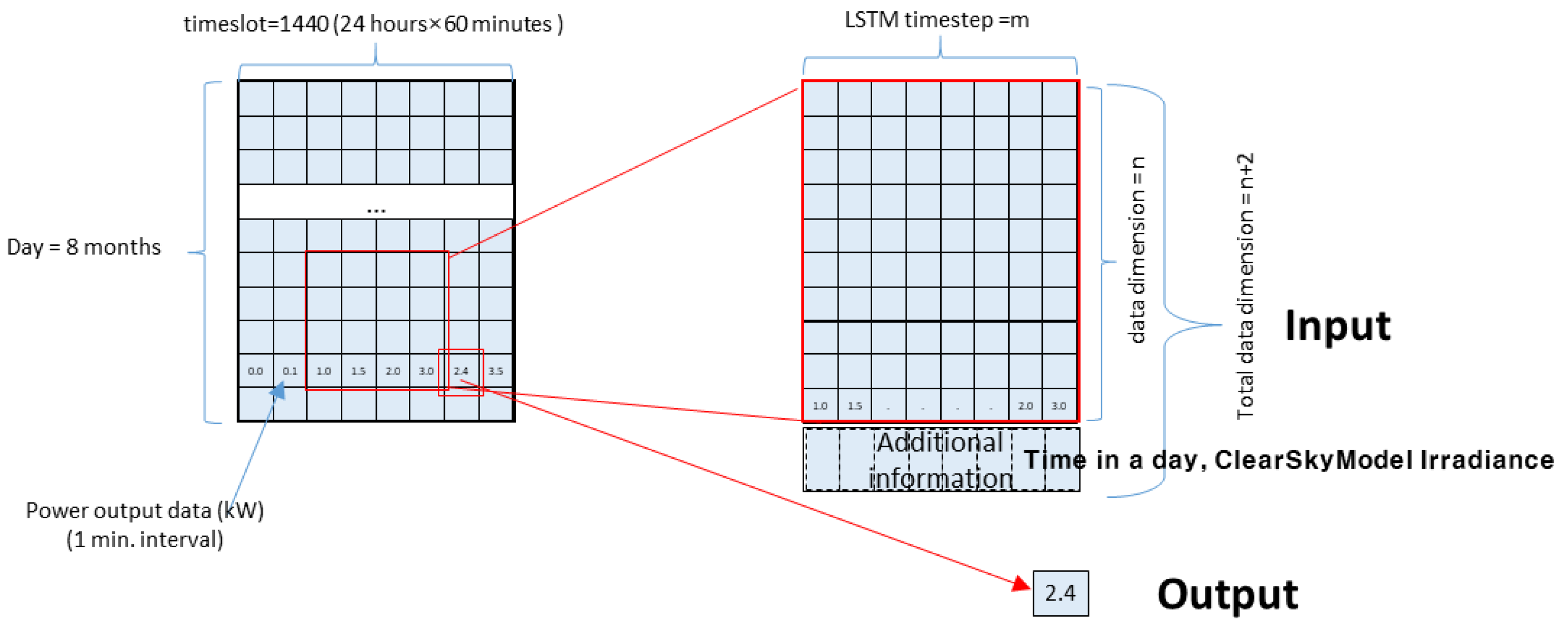
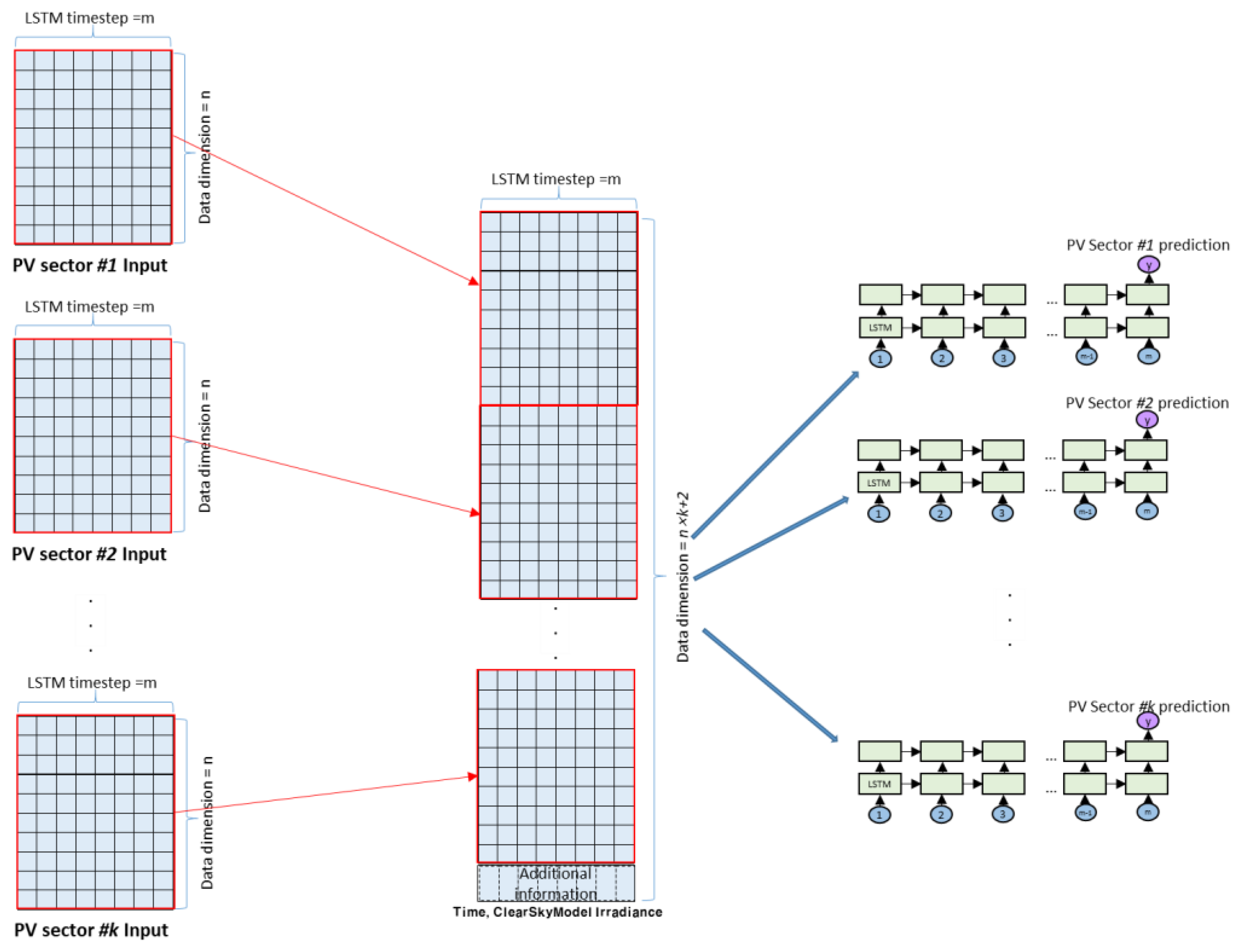
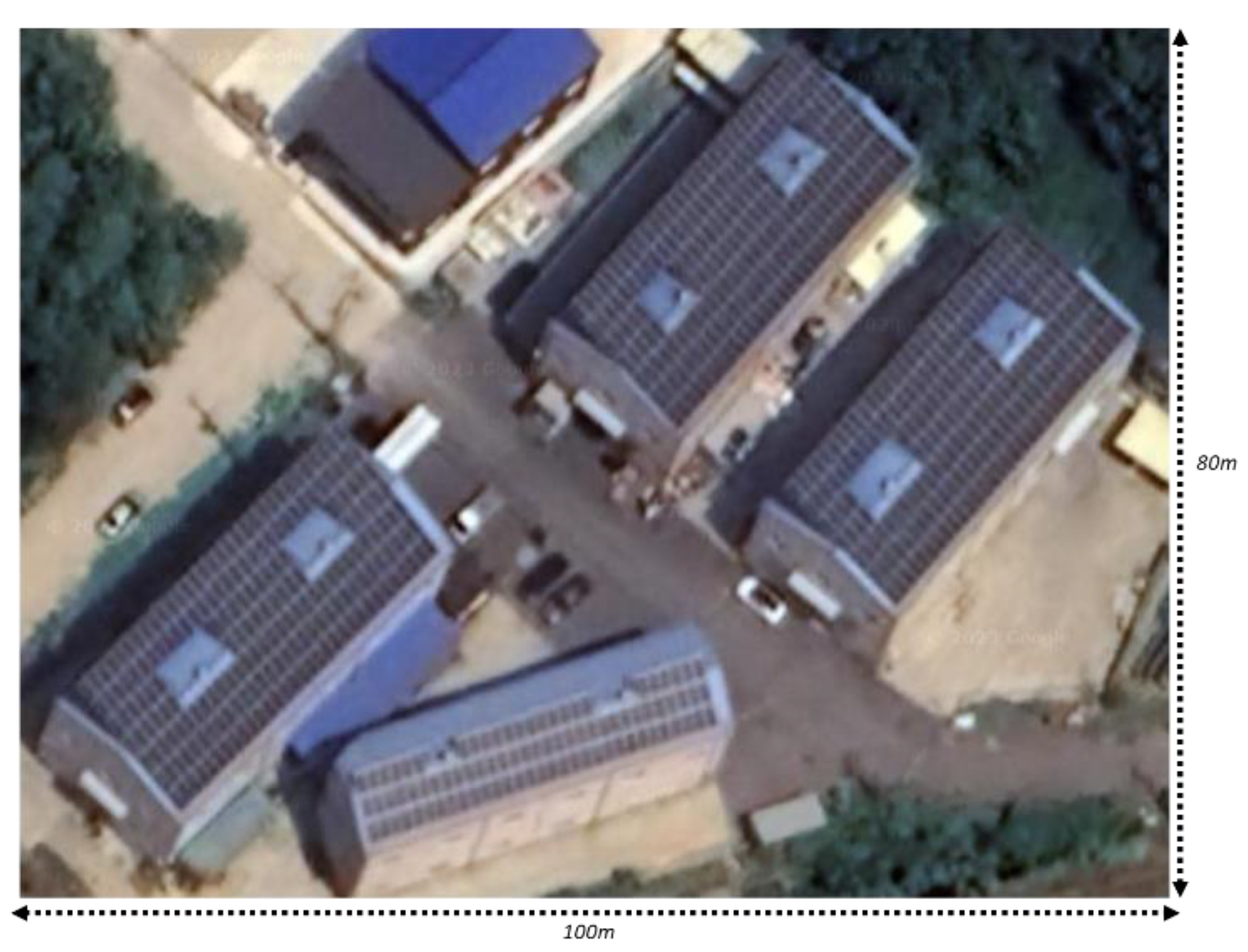
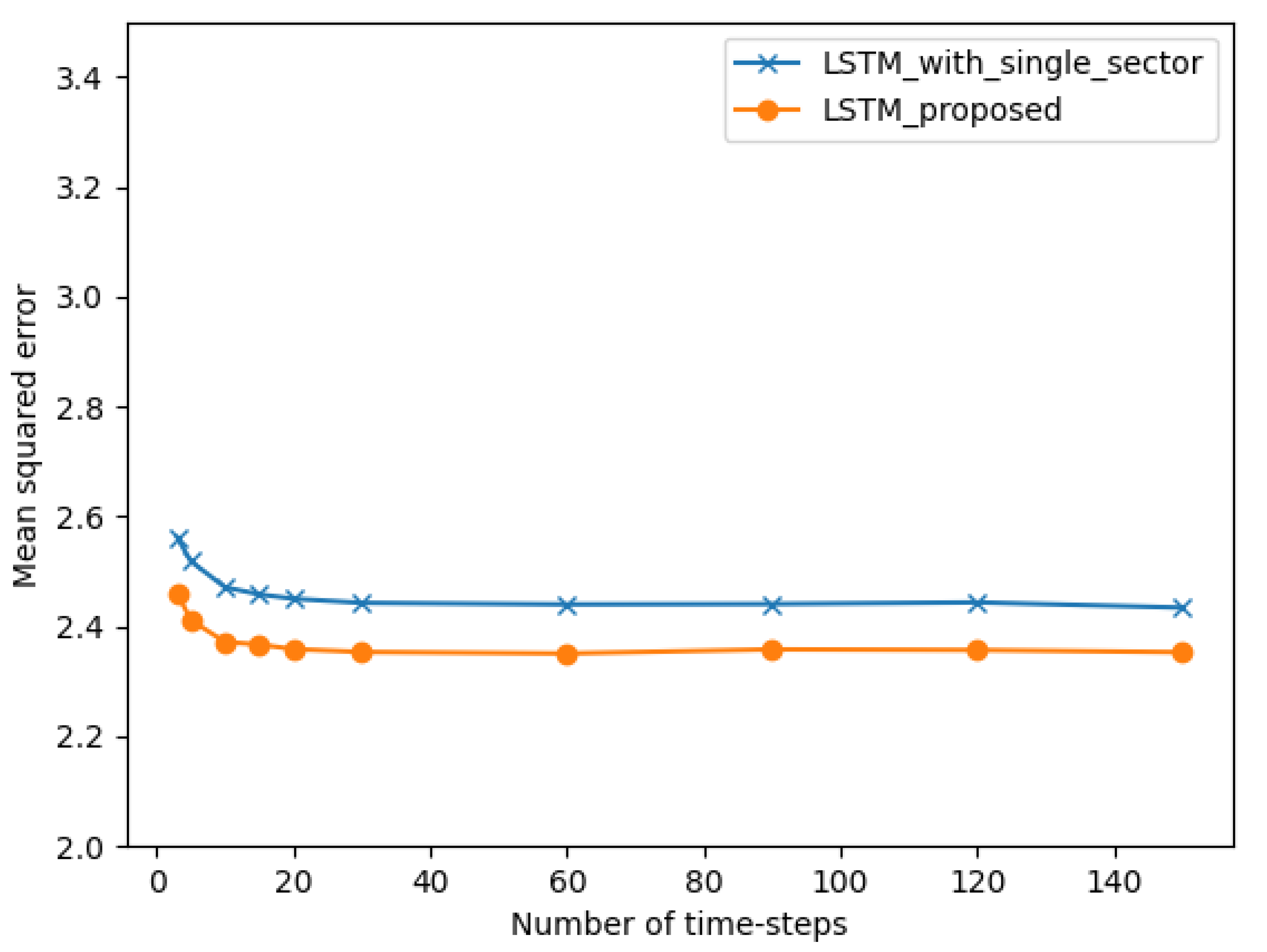
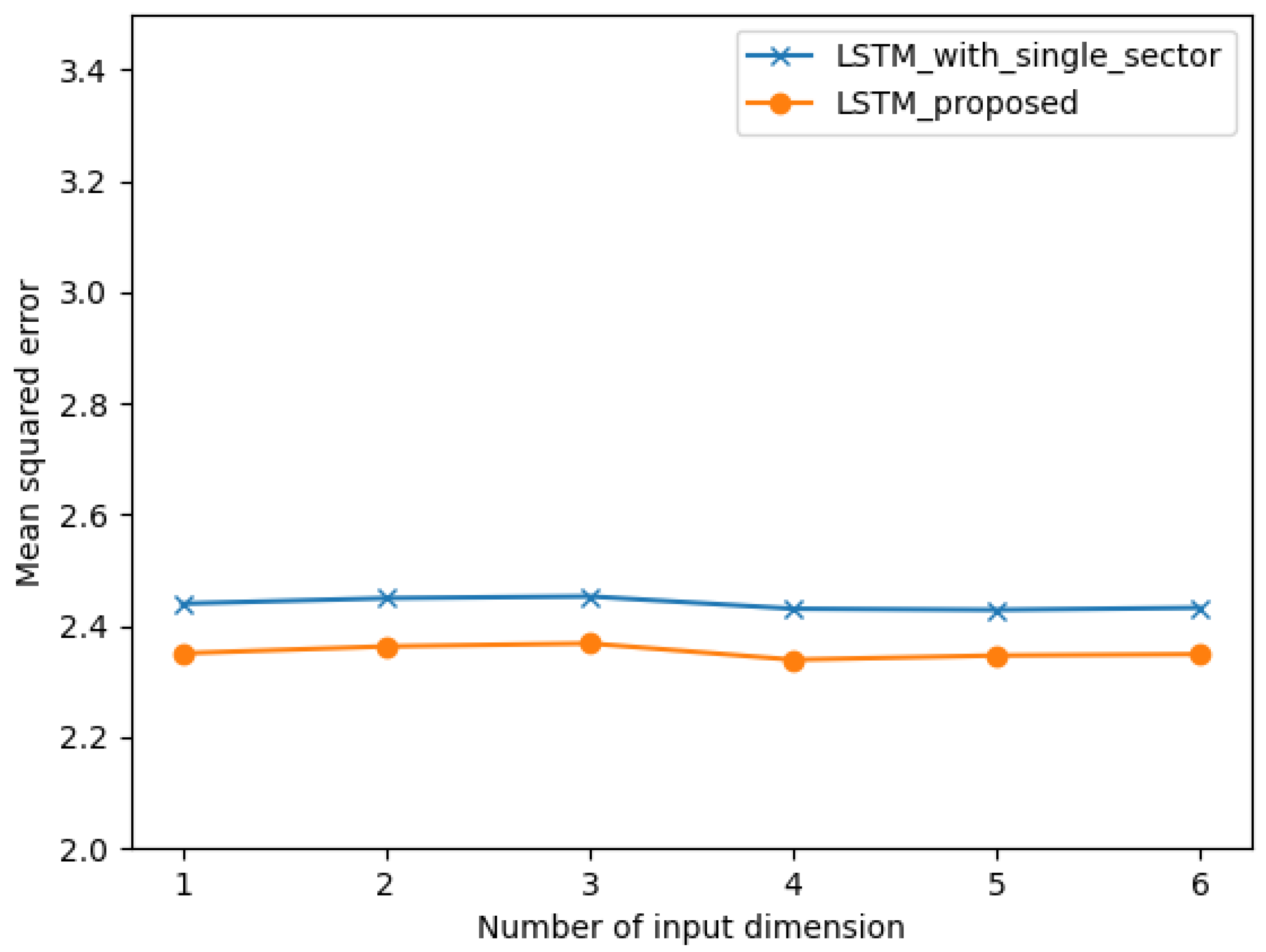
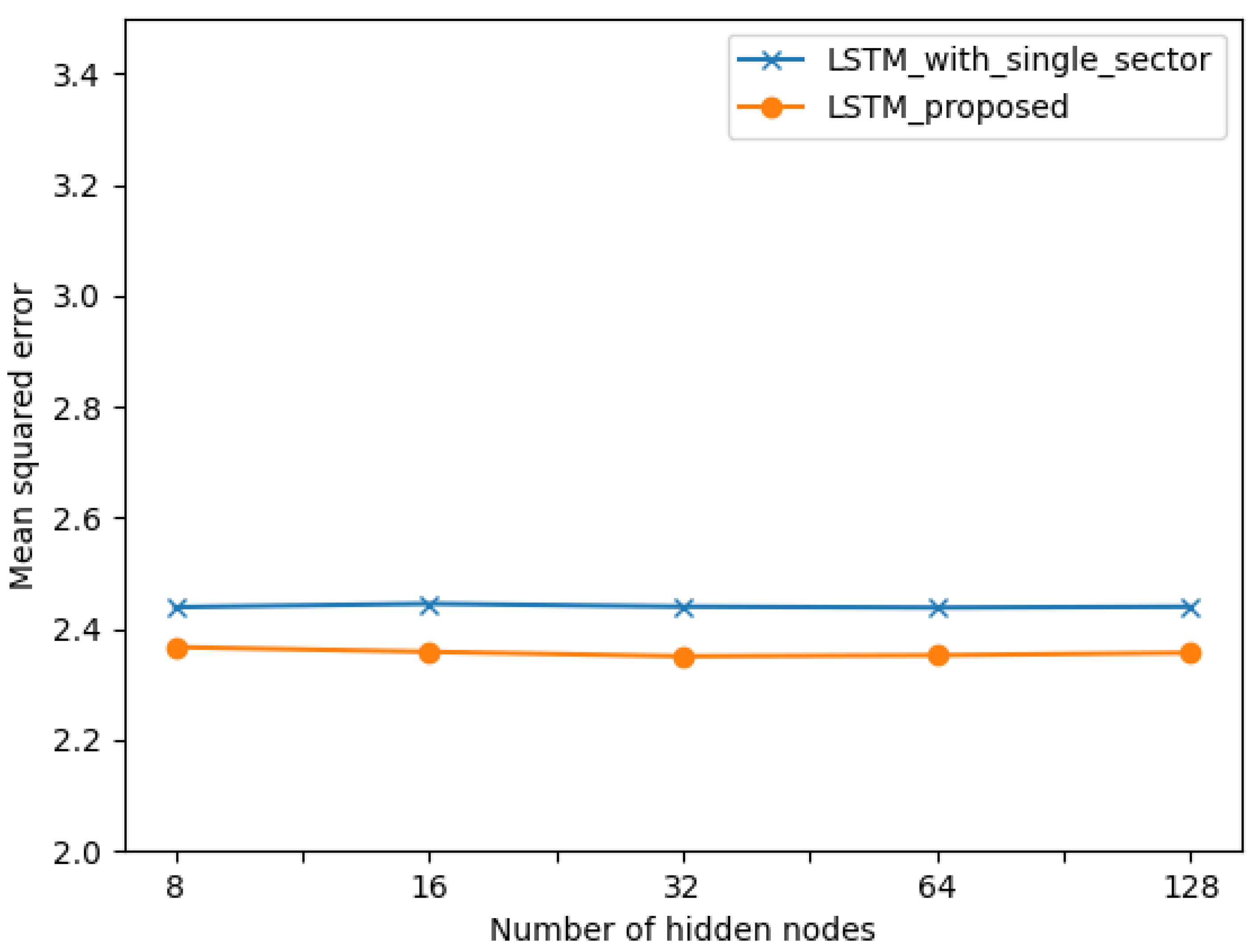
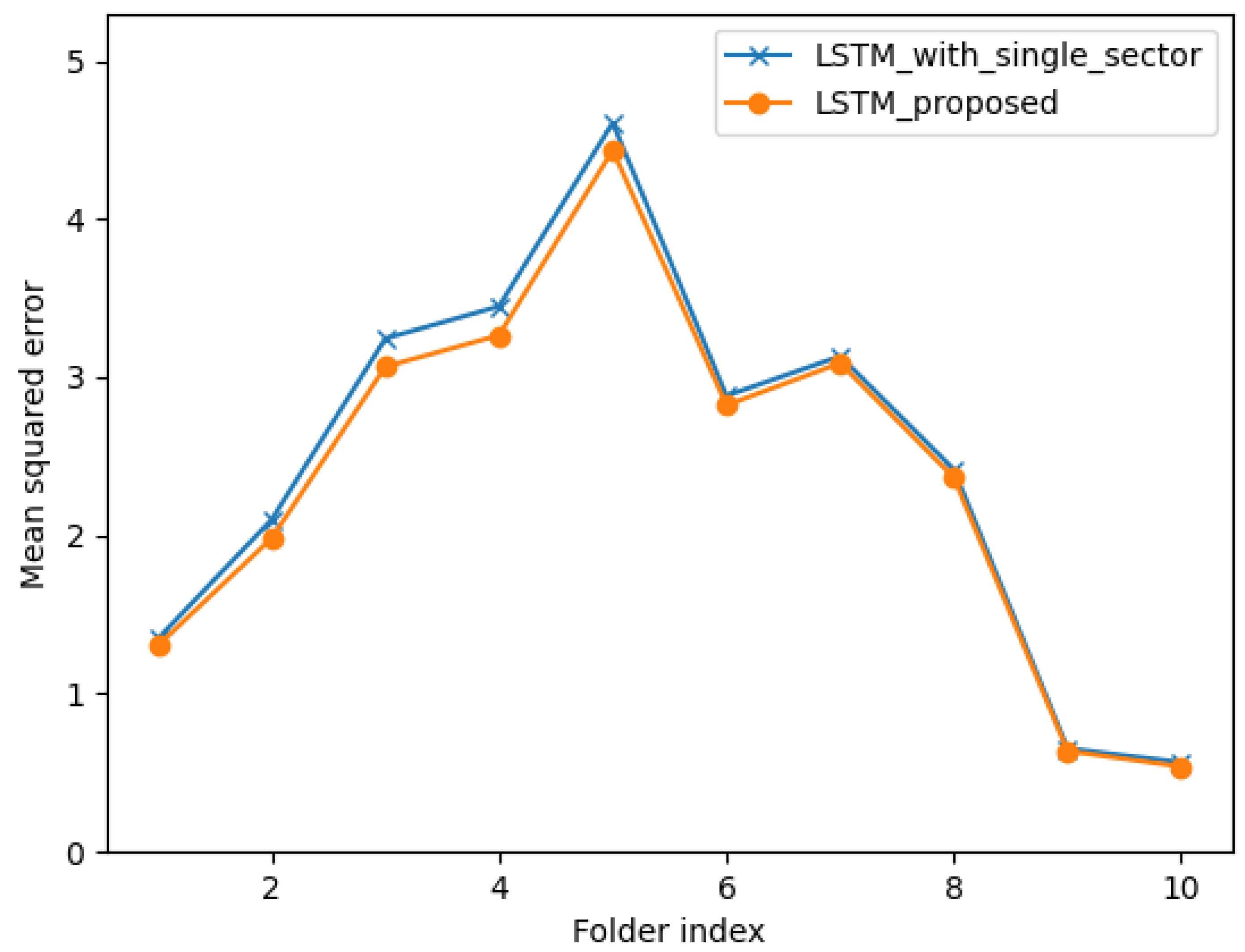
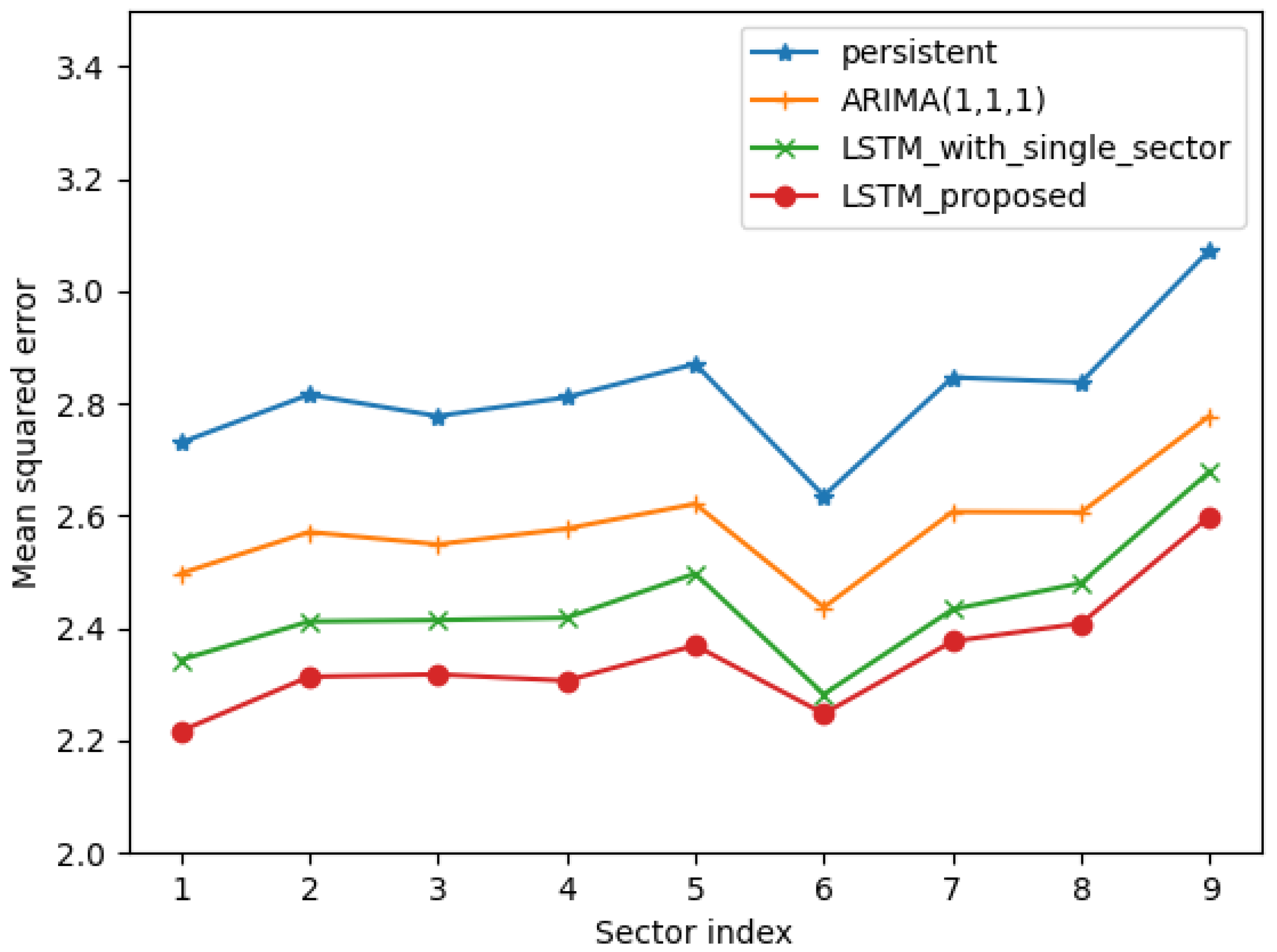
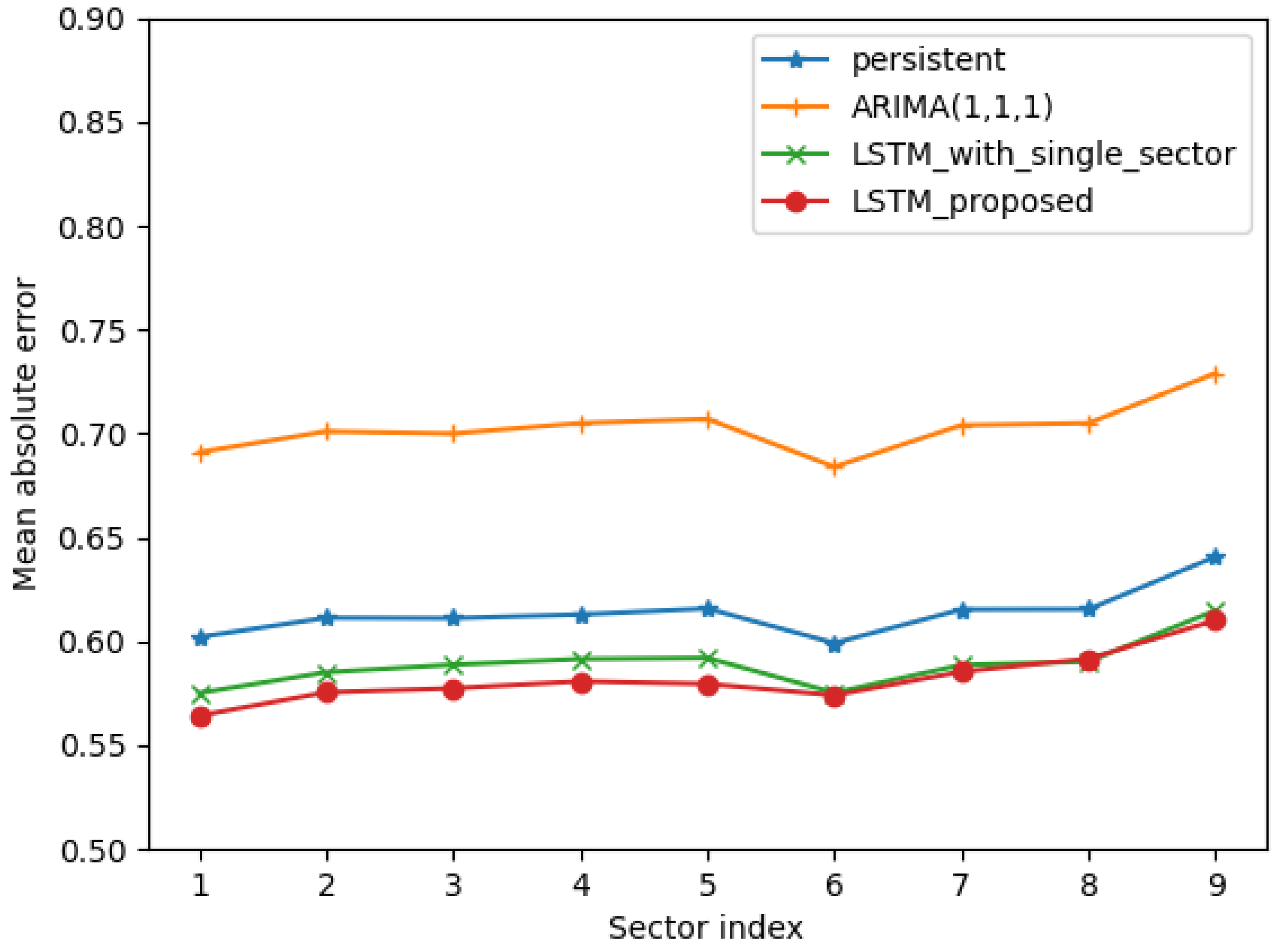
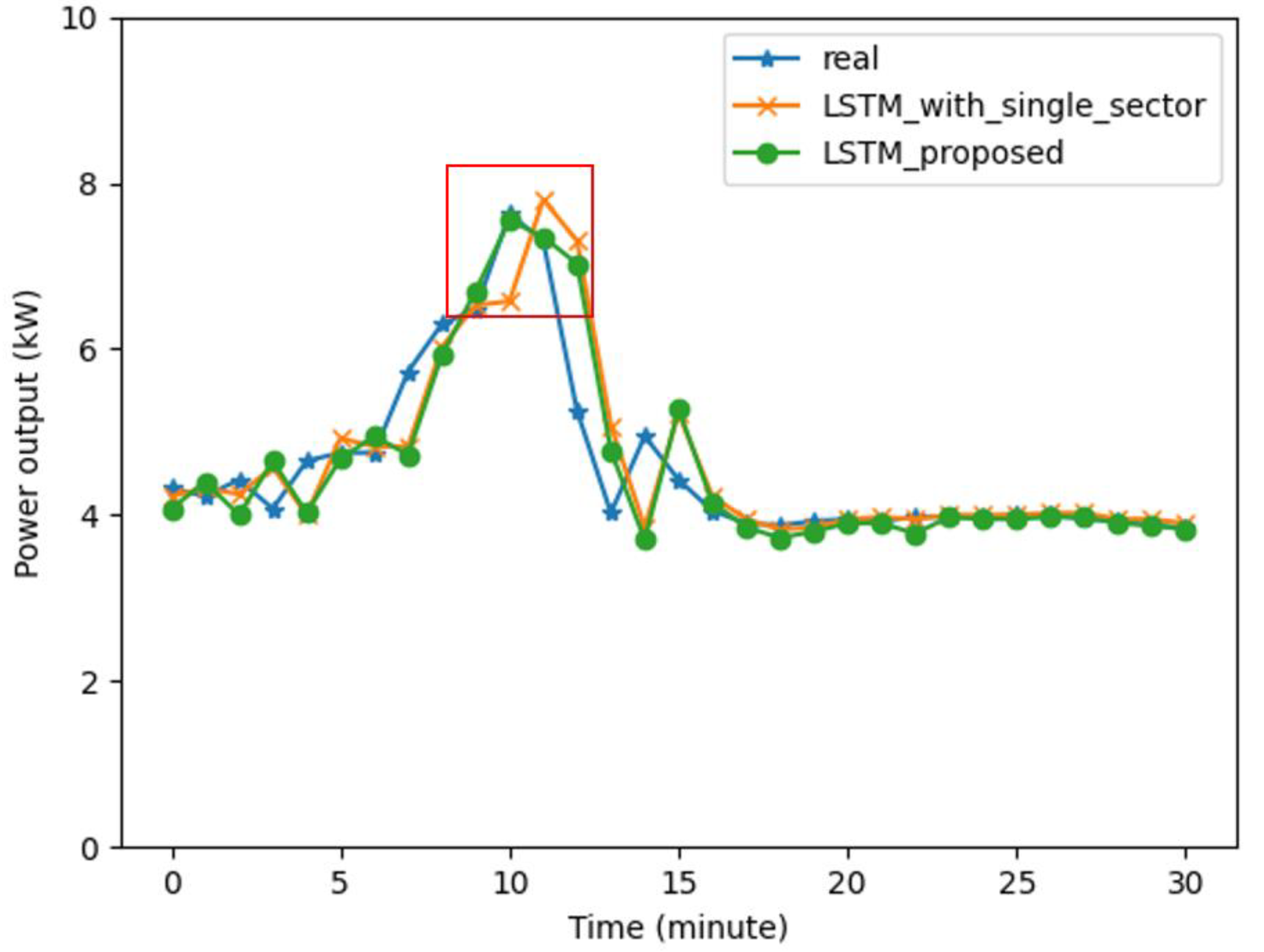
| Persistent | ARIMA (1,1,1) | LSTM_with_Single_Sector | LSTM_Proposed | |
|---|---|---|---|---|
| Sector #1 | 0.065981 | 0.063107 | 0.061131 | 0.059457 |
| Sector #2 | 0.066797 | 0.063831 | 0.061823 | 0.060548 |
| Sector #3 | 0.066368 | 0.063583 | 0.061879 | 0.060629 |
| Sector #4 | 0.066953 | 0.064110 | 0.062104 | 0.060649 |
| Sector #5 | 0.067659 | 0.064655 | 0.063108 | 0.061468 |
| Sector #6 | 0.064702 | 0.062220 | 0.060213 | 0.059754 |
| Sector #7 | 0.067347 | 0.064456 | 0.062270 | 0.061541 |
| Sector #8 | 0.067244 | 0.064444 | 0.062871 | 0.061952 |
| Sector #9 | 0.069987 | 0.066536 | 0.065340 | 0.064362 |
| Average | 0.067004 | 0.064104 | 0.062304 | 0.061151 |
| Persistent | ARIMA (1,1,1) | LSTM_with_Single_Sector | LSTM_Proposed | |
|---|---|---|---|---|
| Sector #1 | 0.024044 | 0.027596 | 0.02297 | 0.022535 |
| Sector #2 | 0.024337 | 0.027906 | 0.023294 | 0.022909 |
| Sector #3 | 0.02434 | 0.027877 | 0.023449 | 0.022996 |
| Sector #4 | 0.024478 | 0.028155 | 0.023624 | 0.023194 |
| Sector #5 | 0.024593 | 0.028235 | 0.023644 | 0.023146 |
| Sector #6 | 0.023882 | 0.027262 | 0.022930 | 0.022882 |
| Sector #7 | 0.024565 | 0.028104 | 0.023500 | 0.023370 |
| Sector #8 | 0.024570 | 0.028144 | 0.023566 | 0.023619 |
| Sector #9 | 0.025579 | 0.029102 | 0.024547 | 0.024357 |
| Average | 0.024487 | 0.028042 | 0.023503 | 0.023223 |
Disclaimer/Publisher’s Note: The statements, opinions and data contained in all publications are solely those of the individual author(s) and contributor(s) and not of MDPI and/or the editor(s). MDPI and/or the editor(s) disclaim responsibility for any injury to people or property resulting from any ideas, methods, instructions or products referred to in the content. |
© 2023 by the authors. Licensee MDPI, Basel, Switzerland. This article is an open access article distributed under the terms and conditions of the Creative Commons Attribution (CC BY) license (https://creativecommons.org/licenses/by/4.0/).
Share and Cite
Kang, J.; Lee, J.; Lee, S. Data-Driven Minute-Ahead Forecast of PV Generation with Adjacent PV Sector Information. Energies 2023, 16, 4905. https://doi.org/10.3390/en16134905
Kang J, Lee J, Lee S. Data-Driven Minute-Ahead Forecast of PV Generation with Adjacent PV Sector Information. Energies. 2023; 16(13):4905. https://doi.org/10.3390/en16134905
Chicago/Turabian StyleKang, Jimyung, Jooseung Lee, and Soonwoo Lee. 2023. "Data-Driven Minute-Ahead Forecast of PV Generation with Adjacent PV Sector Information" Energies 16, no. 13: 4905. https://doi.org/10.3390/en16134905
APA StyleKang, J., Lee, J., & Lee, S. (2023). Data-Driven Minute-Ahead Forecast of PV Generation with Adjacent PV Sector Information. Energies, 16(13), 4905. https://doi.org/10.3390/en16134905







